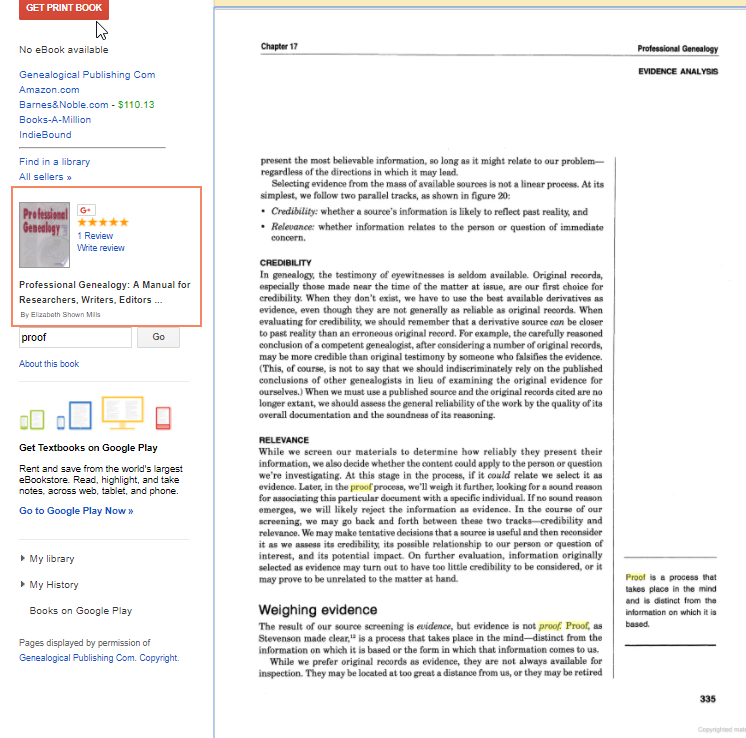
Here's food for thought for all of us who use online books, magazines, newspapers, or snippets thereof.
Last week, a well-known news corp published an article about a false genealogical claim by a public figure. To determine genealogical standards, the reporter went online and Googled for “professional genealogy.” That yielded a hit from Google Books offering sample pages from a textbook conveniently titled Professional Genealogy: A Manual for Researchers, Writers, Editors, Lecturers, and Librarians.
The book is one for which I planned the content, wrote five chapters, chose the best practitioners possible to draft chapters on the other twenty-four topics, edited each chapter individually, and synched the final content of the whole to produce a cohesive course of instruction. Consequently, my name is on the cover and title page, accompanied by the word “Editor.”
However …
-
The two passages the reporter chose to quote were not from any of the five chapters I personally wrote.
-
To introduce the quote, the reporter wrote, “Mills said …”
-
The two chapter authors who actually wrote the two quoted passages weren’t identified.
We might pounce and say: “Aha! Sloppy reporting!” But there’s a bigger issue here that ensnares many researchers. How careful are we when we use online snippets or samples of books, magazines, and newspapers?
Take a look at this image ...

Here, we have a screen capture of one of the pages from which the reporter quoted a passage—as delivered by Google Books. When I used GB’s query box to “get into” the digital book that could not be physically thumbed, I queried for the key word “proof.” GB gave me a list of pages with that word. When I chose p. 335, GB delivered what you see in this screen capture.
Do you see an author’s name on the actual page of the book? The running head on each page does what running heads usually do for books of this type. It gives the book title, the chapter number, and the chapter name. As history researchers or reporters (which are one and the same), when we use Google Books (or anything of its ilk) and find a passage we want to use, where do we get the “author’s name"?
In the left column of this screen’s framework, Google cites the book title and author, no? We’re told the book is “Professional Genealogy … By Elizabeth Shown Mills.” Do we see anything on this screen to alert us that each chapter is written by a different author? No.
So now, it’s now confession time. Well, at least introspection time:
-
When we use online snippets or page samples from books, magazines, and newspapers: do we try to access the whole entity to study its composition?
-
If the delivery mode allows it, do we scroll back to the title page, the table of contents, and the foreword, to get a better perspective of what the book is about?
-
For that matter, when we use any book—digital or physical—to “look up” something, do we thumb back to the start of the chapter where we found the pithy passage we want to quote?
Obviously, we should. Not only might we learn that the chapter has a special author who is not named on the book cover* but the remarks that introduce the chapter on, say, page 329 often provide important context for that one specific passage on page 335 in which we’re interested.
Trust me, this is a wide-spread problem. Even users of Evidence Explained, when they “look up” a citation model for a specific source, forget to thumb back to the start of that chapter to read the introductory passages explaining the quirks of that type of record.
As history researchers, one of the first things we're taught (or should be) is that context matters and accuracy matters. As modern researchers, we feast on digital content. As with dining in restaurants rather than eating home-cooked meals, the manner of delivery often obscures essential details about the ingredients, the cook, and the preparation methods. Though not obvious, those essential details still exist. It's up to us to make the extra effort to learn about what we're using so that we don't choke on our unintended mistakes.
4 December 2017
*How many of you, when you cite Chapter 4 of Chicago Manual of Style, 16th or 17th editions, actually credit William S. Strong? How many of you, when citing chapter 5, credit Bryan A. Garner for that chapter? Or do you just, generically, cite CMOS itself? It’s been seven years since the 16th edition was printed and never once have I seen a citation to CMOS 4.__ or 5.__ that credits Strong or Garner.
HOW TO CITE:
Elizabeth Shown Mills, "Sloppy Reporting? Or, How Not to Choke When Indulging in Online Content," QuickTips: The Blog@EvidenceExplained (https://www.evidenceexplained.com/quicktips/sloppy-reporting-or-how-not-choke-when-indulging-free-online-content : posted 4 December 2017).